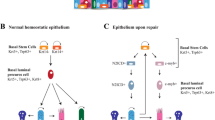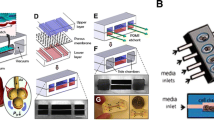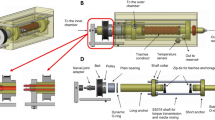Abstract
The high demand for lung transplants cannot be matched by an adequate number of lungs from donors. Since fully ex-novo lungs are far from being feasible, tissue engineering is actively considering implantation of engineered lungs where the devitalized structure of a donor is used as scaffold to be repopulated by stem cells of the receiving patient. A decellularized donated lung is treated inside a bioreactor where transport through the tracheobronchial tree (TBT) will allow for both deposition of stem cells and nourishment for their subsequent growth, thus developing new lung tissue. The key concern is to set optimally the boundary conditions to utilize in the bioreactor. We propose a predictive model of slow liquid ventilation, which combines a one-dimensional (1-D) mathematical model of the TBT and a solute deposition model strongly dependent on fluid velocity across the tree. With it, we were able to track and drive the concentration of a generic solute across the airways, looking for its optimal distribution. This was given by properly adjusting the pumps’ regime serving the bioreactor. A feedback system, created by coupling the two models, allowed us to derive the optimal pattern. The TBT model can be easily invertible, thus yielding a straightforward flow/pressure law at the inlet to optimize the efficiency of the bioreactor.






Similar content being viewed by others
References
Lung Association: Fact sheet: chronic obstructive pulmonary disease (COPD) (online). http://www.lugusa.org
Pulmonary Fibrosis Association: What is pulmonary fibrosis? (online). http://www.pulmonaryfybrosis.org/ipf.htm
Yusen, R.D., Edwards, L.B., Kucheryavaya, A.Y., et al.: The registry of the international society for heart and lung transplantation: thirty-first adult lung and heart-lung transplant report—2014; focus theme: retransplantation. J. Heart Lung Transpl. 33(10), 1009–1024 (2014)
Egan, T.M., Kaiser, L.R., Cooper, J.D.: Lung transplantation. Curr. Probl. Surg. 26(10), 681–751 (1989)
Cypel, M., Liu, M.Y., Rubacha, M., et al.: Functional repair of human donor lungs by IL-10 gene therapy. Sci. Transl. Med. 1(4), 4ra9 (2009)
Calay, R.K., Kurujareon, J., Holdo, A.E.: Numerical simulation of respiratory flow patterns within human lung. Respir. Physiol. Neurobiol. 130(2), 201–221 (2001)
Freitas, R.K., Schröder, W.: Numerical investigation of the three-dimensional flow in a human lung model. J. Biomech. 41(11), 2446–2457 (2008)
Yu, C.C., Hsiao, H.D., Lee, L.C., et al.: Computational fluid dynamic study on obstructive sleep apnea syndrome treated with maxillomandibular advancement. J. Craniofac. Surg. 20(2), 426–430 (2009)
Martonen, T.B., Quan, L., Zhang, Z., et al.: Flow simulation in the human upper respiratory tract. Cell Biochem. Biophys. 37(1), 27–36 (2002)
Hyatt, R.E., Schilder, D.P., Fry, D.L.: Relationship between maximum expiratory flow and degree of lung inflation. J. Appl. Physiol. 13(3), 331–336 (1958)
Costantino, M.L., Fiore, G.B.: A model of neonatal tidal liquid ventilation mechanics. Med. Eng. Phys. 23(7), 459–473 (2001)
Costantino, M.L., Fiore, G.B.: Liquid ventilation: a mathematical model of gas diffusion in the premature lung. Med. Eng. Phys. 19(2), 157–163 (1997)
Corno, C., Fiore, G.B., Costantino, M.L.: A mathematical model of neonatal tidal liquid ventilation integrating airway mechanics and gas transfer phenomena. IEEE Trans. Biomed. Eng. 51(4), 604–611 (2004)
Corno, C., Fiore, G.B., Martelli, E., et al.: Volume controlled apparatus for neonatal tidal liquid ventilation. ASAIO J. 49(3), 250–258 (2003)
Florens, M., Sapoval, B., Filoche, M.: An anatomical and functional model of the human tracheobronchial tree. J. Appl. Physiol. 110(3), 756–763 (2010)
Florens, M.: Morphologie et transport dans I’arbre tracheobronchique humain: modeles, properties et applications. Ph.D. dissertation, Ecole normale superieure de Cachan, City of Cachan (2011)
Petersen, T.H., Calle, E.A., Zhao, L., et al.: Tissue-engineered lungs for in vivo implantation. Science 329(5991), 538–541 (2010)
Nichols, J.E., Niles, J., Riddle, M., et al.: Production and assessment of decellularized pig and human lung scaffolds. Tissue Eng. Part A 19(17–18), 2045–2062 (2013)
West, J.B.: Respiratory Physiology: The Essential, 9th edn. Lippincott Williams & Wilkins, Baltimore (2012)
Weibel, E.R. (ed.) The lung’s mechanical support. In: The Pathway for Oxygen, pp. 302–338. Harvard University Press, Cambridge
Weibel, E.R., Sapoval, B., Filoche, M.: Design of peripheral airways for efficient gas exchange. Respir. Physiol. Neurobiol. 148, 3–21 (2005)
Reinartz, P., Wildberger, J.E., Schaefer, W., et al.: Tomographic imaging in the diagnosis of pulmonary embolism: a comparison between V/Q lung scintigraphy in SPECT technique and multislice spiral CT. J. Nucl. Med. 45(9), 1501–1508 (2004)
Tani, G., Carfagnini, F., Coli, L., et al.: Diagnostica per immagini: ecografia ed eco-color-Doppler. In: Mirabile, L., Baroncini, S. (eds.) Rianimazione in età pediatrica, pp. 635–648. Springer, Milan (2012)
Lam, S., Kennedy, T., Unger, M., et al.: Localization of bronchial intraepithelial neoplastic lesions by fluorescence bronchoscopy. Chest 113(3), 696–702 (1998)
Brown, M.S., Mcnitt-Gray, M.F., Mankovich, N.J., et al.: Method for segmenting chest CT image data using an anatomical model: preliminary results. IEEE Trans. Med. Imaging 16(6), 828–839 (1997)
Choi, J., Tawhai, M., Hoffman, E.A., et al.: On intra- and intersubject variabilities of airflow in the human lungs. Phys. Fluids 21(10), 101901 (2009)
Lambert, R.K., Wilson, T.A., Hyatt, R.E., et al.: A computational model for expiratory flow. J. Appl. Physiol. 52(1), 44–56 (1982)
Murray, C.D.: The physiological principle of minimum work applied to the angle of branching of arteries. J. Gen. Physiol. 9(6), 835–841 (1926)
Salazar, E., Knowels, E.H.: An analysis of pressure volume characteristics of the lungs. J. Appl. Physiol. 19(1), 97–104 (1964)
Armstrong, J.D., Gluck, E.H., Crapo, R.O., et al.: Lung tissue volume estimated by simultaneous radiography and helium dilution methods. Thorax 37(9), 676–679 (1982)
Quarteroni, A., Veneziani, A.: Analysis of a geometrical multiscale model based on the coupling of ODEs and PDEs for blood flow simulations. Multiscale Model. Simul. 1(2), 173–195 (2006)
Acknowledgements
The project was supported by the Atlantis International (Grant P11GJ10-0067). In studying the bioreactor of the Houston Methodist Research Institute we received a very helpful input from Jason Sakamoto.
Author information
Authors and Affiliations
Corresponding author
Appendices
Appendix 1
The basic equations that define the bronchial compliance correspond to two hyperbolas, defined according to whether the transmural pressure in positive (pressure inside the bronchus greater than that of environment) or negative, according to Lambert et al. [27].
Appendix 2
The equation of alveolar pressure and intrapleural pressure were defined as follow
Last term of Eq. (A3) writes
where \(P_{\mathrm{m}}\) is the maximum respiratory pressure, t time of respiratory cycle, \(\tau \) the constant of time referred to the dissipation of \(P_{\mathrm{m}}, V_{\mathrm{R}}\) the residual volume, \(C_{\mathrm{V}}\) the vital capacity, \(V_{\mathrm{L}}(t)\) the instantaneous lung volume, \(R_{\mathrm{t}}\) the resistance offered by lung tissues, \(\varPhi _{0}(t)\) is the flow in trachea, \(V_{\mathrm{max} }\) and \(V_{\mathrm{min}}\) are the maximum and the minimum lung volume, and \(C_{\mathrm{L0}}\) the global compliance value if \(P_{\mathrm{tm}}\) is null.
Appendix 3
Bernoulli’s law was applied between the inlet of the bronchus and a generic point x of it, giving Eq. (A5):
where \(P_{\mathrm{A}}, v_{\mathrm{A}}, z_{\mathrm{A}}\) are respectively the pressure, the velocity of the fluid, and the geodesic share at the inlet point of the bronchus. The same quantities P(x), v(x), and z(x) are referred to the current point x of the bronchus; \(\rho \) is the density of the fluid, g is the gravity acceleration constant and finally \(\Delta P_{(\mathrm{A-}x)}\).
According with the assumptions made, Eq. (A5) can be rewritten in the form shown with Eq. (A6):
where f(x) represents the loss of pressure per unit of length and it has the following form
where \(\eta \) is the viscosity of the fluid, a and b are phenomenological constants, Re(x) is the Reynolds number in the x point of the bronchus, D(x) the hydrodynamic equivalent diameter of the bronchus in point x, and finally \(\vartheta \) the longitudinal angle of the bronchus.
Equation (A6) was derived with respect to the transmural pressure, leading to Eq. (A8):
where c(x) is the local velocity wave form. The contribution of gravity was not considered replacing Eq. (A7) in Eq. (A6), because gravity does not impact the flow distribution in the air case.
We integrated Eq. (A8) between both ends of the single pipe in order to obtain a scalar nonlinear equation describing the flow inside the single bronchus.
Without considering flow and diameter variability along the bronchus, an average value of the Reynolds number valid for all the length is assumed according with [16]:
The generic function h(P) describes the variation of the bronchus diameter with respect to the transmural pressure value. Its definition takes in account the sign of \(P_{\mathrm{tm}}\), giving the following forms:
Appendix 4
We are going to derive a simplified model of transport of solute starting from the flow distribution across the bronchial tree described earlier. The relevant mass balance is written as
where \(C_{\mathrm{A}}\) represents the concentration of a generic solute A, and \(J_{\mathrm{A}}\) the flow per unit of area.
Combining Eq. (A12) with the first Fick law, we obtained
Equation (A13) describes the phenomenon of propagation of a generic solute transported inside a liquid component. \(D_{\mathrm{A}}\) stands for the diffusivity of the solute in the carrying solvent and v is the velocity of the fluid. Equation (A13) writes
The velocity along the longitudinal direction of the bronchus is constant as assumed in Sect. 2.3. We chose a radial symmetric cylindrical approximation for the diffusion. Accordingly, Eq. (A14) turned into
where z is the longitudinal coordinate and r the radial coordinate. Since \(D_{\mathrm{A}}\) is small, the transport of solute along the z-direction is dominated by the convective term only. Our simplified model is written as
Let R be the radius and L the length of the generic bronchus, we assumed \(R\ll L\) and wrote \(\frac{\partial }{\partial r}C_{\mathrm{A}} \left( r \right) \) using a Taylor expansion with \(r\in [0,R]\):
From the radial symmetry assumption, \(\frac{\partial }{\partial r}C_{\mathrm{A}} \left( 0 \right) =0\). We replaced Eq. (A17) in Eq. (A16):
We observed that
For the \(R\ll L\) assumption, \(D_{A} \cdot o(R)\) is negligible.
Let us introduce the concentration of solute per unit of radius \(S_{\mathrm{A}} =\mathop \smallint \nolimits _{-R}^R C_{\mathrm{A}} \hbox {d}r\). Consequently, Eq. (A16) can be reduced as the following simplified form:
We imposed the following equivalence:
where k is the absorption coefficient of the bronchial wall in respect to the solute carried by the liquid flow.
Finally, the finite difference approximation of Eq. (A21) is written as
where \(\Delta T\) stands for time step and \(\Delta Z\) for the discrete spatial step. Equation (A22) allows us to track the concentration of solute in each bronchus both at each time step and at each space step.
Appendix 5
A list of acronyms, abbreviations, and symbols is reported below.
- TBT:
-
Tracheobronchial tree
- SDM:
-
Solute deposition model
- TLV:
-
Total liquid ventilation
- PLV:
-
Partial liquid ventilation
- BC:
-
Boundary condition
- \(P_{\mathrm{tm}}\) :
-
Transmural pressure
- \(P_{\mathrm{int}}\) :
-
Internal pressure
- \(P_{\mathrm{env}}\) :
-
Environmental pressure
- \(P_{\mathrm{atm}}\) :
-
Atmospheric pressure
- \(P_{\mathrm{alv}}\) :
-
Alveolar pressure
- \(P_{\mathrm{pl}}\) :
-
Intrapleuric pressure
- \(P_{\mathrm{m}}\) :
-
Maximum respiratory pressure
- \(\tau \) :
-
Dissipation of \({P}_{\mathrm{m}}\) constant of time
- \(V_{\mathrm{R}}\) :
-
Residual volume
- \(C_{\mathrm{V}}\) :
-
Vital capacity
- \(V_{\mathrm{L}}\) :
-
Lung volume
- \(R_{\mathrm{t}}\) :
-
Lung tissues resistance
- \(\phi _{\mathrm{0}}\) :
-
Flow in trachea
- \(V_{\mathrm{max}}\) :
-
Maximum lung volume
- \(V_{\mathrm{min}}\) :
-
Minimum lung volume
- \(C_{\mathrm{L0}}\) :
-
Global compliance if \(P_{\mathrm{tm}}\)= 0
- \(\eta \) :
-
Fluid velocity
- \(R\hbox {e}(x)\) :
-
Reynolds number in the x point of the bronchus
- D(x):
-
Hydrodynamic equivalent diameter of the bronchus in its point x
- \(\vartheta \) :
-
Spatial orientation of the bronchus
- c(x):
-
Local velocity wave form
- \(h(P_{\mathrm{tm}})\) :
-
Variation of the bronchus diameter respect to the transmural pressure
- D(\(P_{\mathrm{tm}})\) :
-
Diameter of flexible bronchus
- \(C_{{\mathrm{O}}_2 } ^{m}\) :
-
Oxygen concentration at position \(x=m\)
- \(D_{\mathrm{max}}\) :
-
Diameter of the rigid bronchus
- \(C_{\mathrm{A}}\) :
-
Concentration of the generic solute A
- \(\Delta V\) :
-
Infinitesimal volume
- \(J_{{\mathrm{A}}|x}\) :
-
Flow per unit of area recorded at position x of \(\Delta V\)
- \(D_{\mathrm{A}}\) :
-
Solute A diffusivity
- \(N_{\mathrm{FL}}\) :
-
Phases number of the pressure waveform
- \(u_{{n}}(z)\) :
-
Actual velocity
- \(v_{{n}}(z)\) :
-
Nominal velocity
- \(\phi \) :
-
Flow
- \({[}{\hbox {O}}_{2}{]}\) :
-
Oxygen concentration
- RMS:
-
Root mean square
- \(C_{\mathrm{{O}}_2 } ^{n}\) :
-
Oxygen concentration at time \(t= n\)
Rights and permissions
About this article
Cite this article
Casarin, S., Aletti, F., Baselli, G. et al. Optimal flow conditions of a tracheobronchial model to reengineer lung structures. Acta Mech. Sin. 33, 284–294 (2017). https://doi.org/10.1007/s10409-017-0644-0
Received:
Revised:
Accepted:
Published:
Issue Date:
DOI: https://doi.org/10.1007/s10409-017-0644-0




